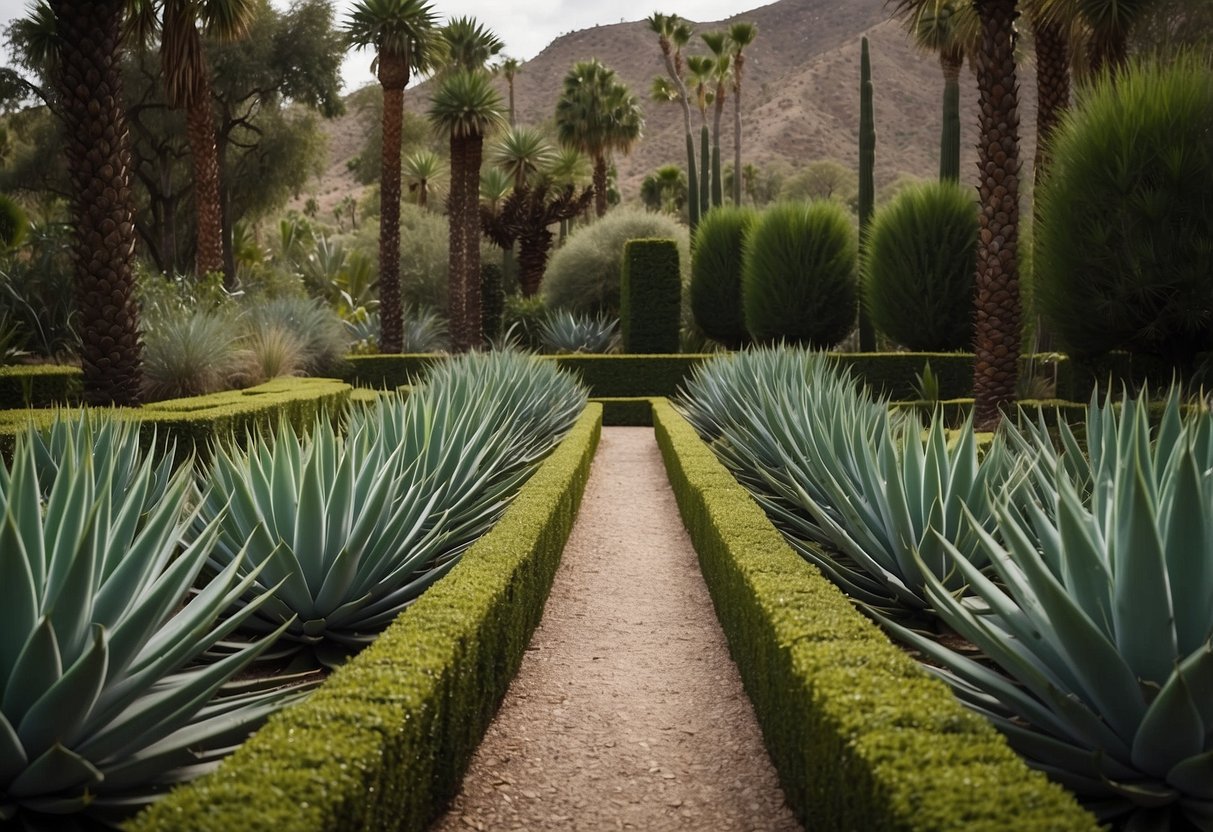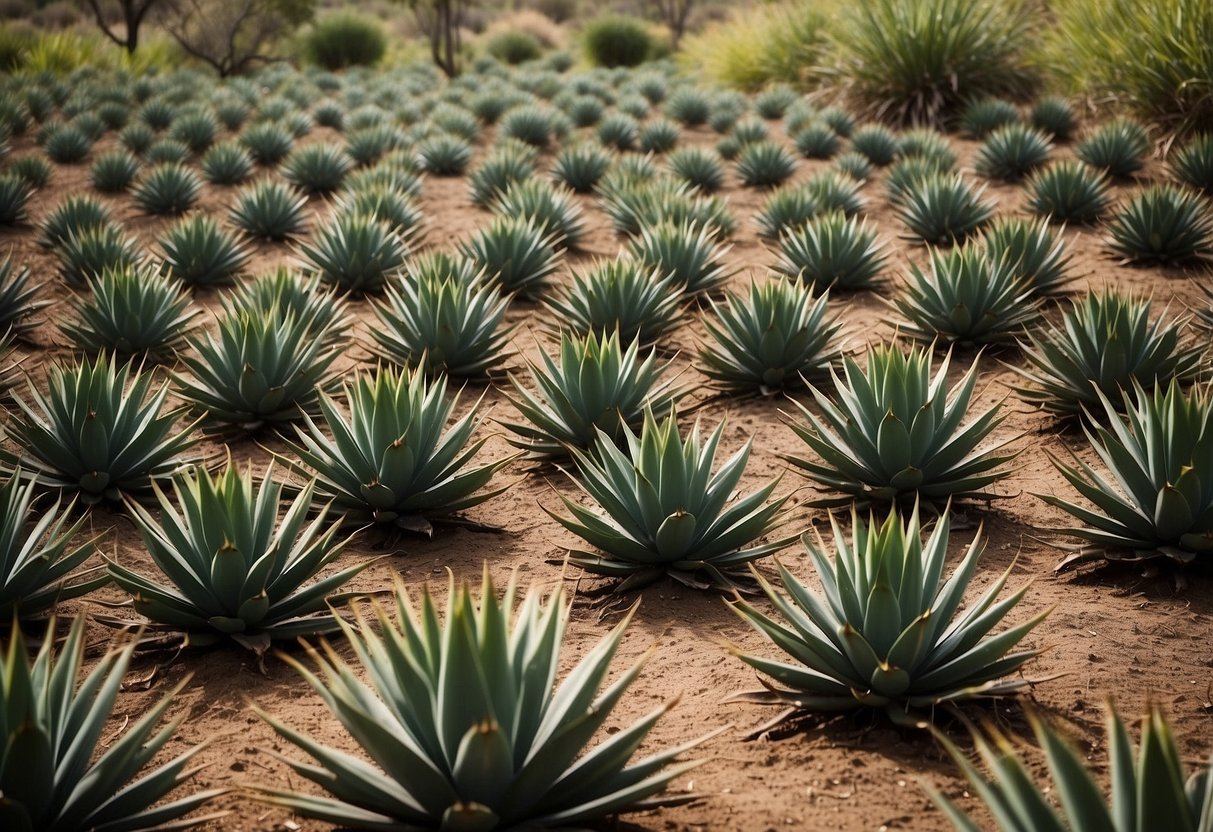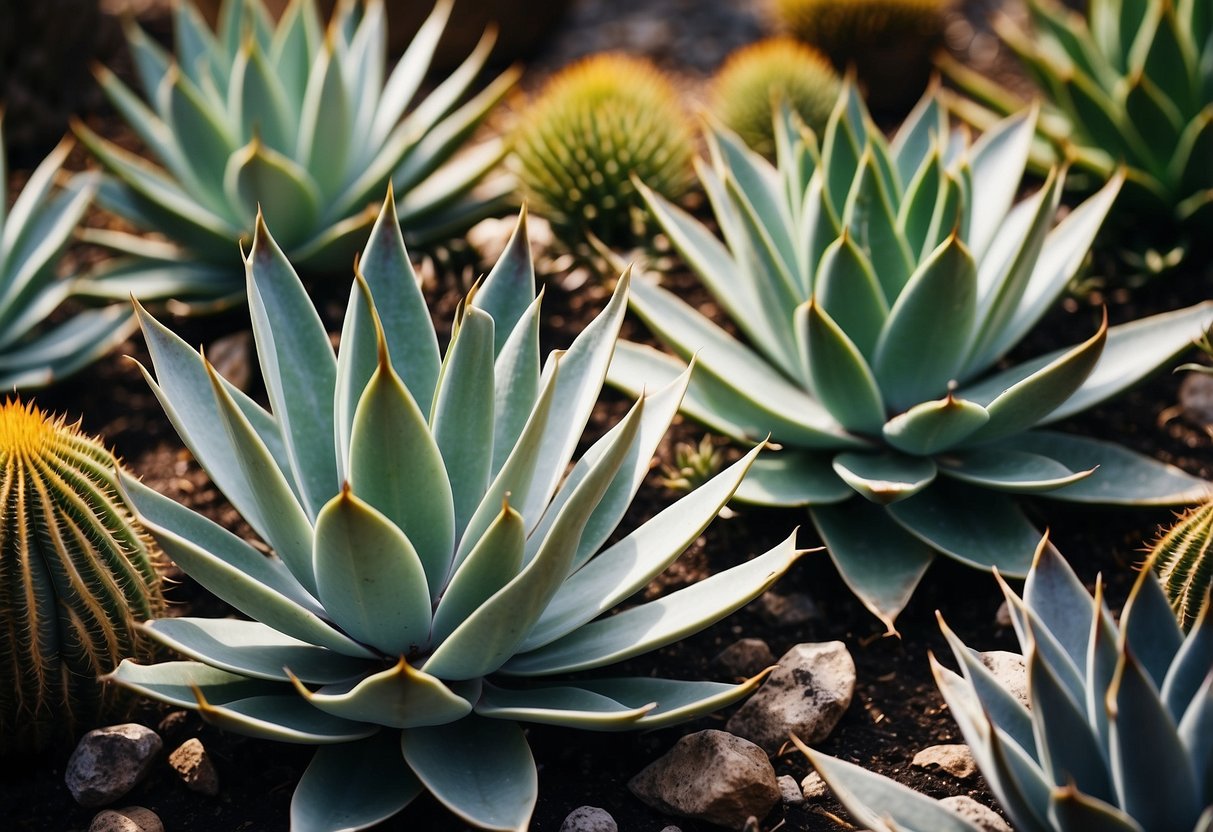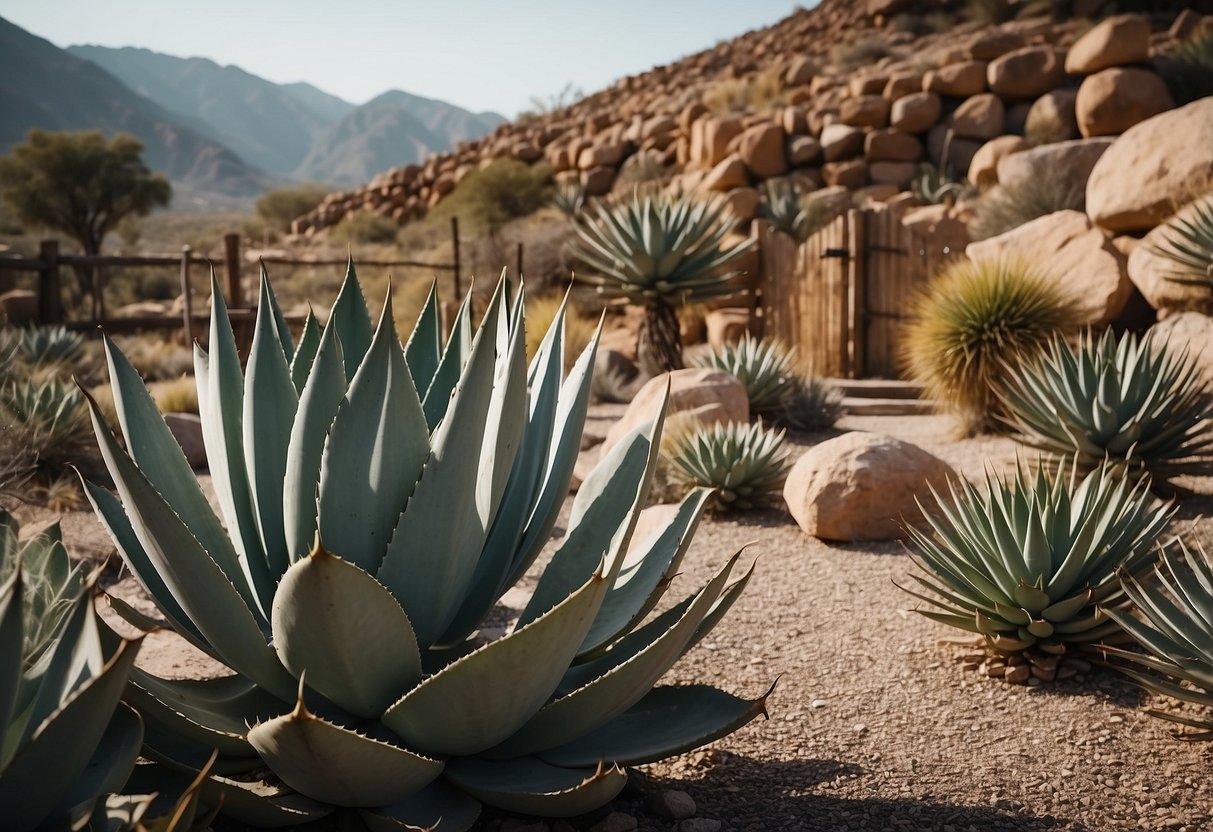Agave Plant Garden Ideas: Creative Ways to Transform Your Yard
Looking to spice up your garden with some unique and low-maintenance plants? Agave plants might be just what you need. These succulents are perfect for creating stunning landscapes that require minimal water and care.

Agave plants offer a wide variety of textures and shapes, making them ideal for both small and large garden spaces. Whether you pair them with other succulents, grasses, or drought-tolerant flowers, you can craft a visually appealing and sustainable garden.
1) Agave Americana

Agave Americana, also known as the Century Plant, is a stunning addition to any garden. This large, evergreen perennial forms rosettes of thick, blue-green leaves that can reach up to 6 feet in length. The older leaves often arch down, creating a graceful look.
This plant thrives in growing zones 8 to 11. It requires a dry climate and good drainage to avoid sitting in water. You can add sand or grit to clay-based soil to ensure it drains well.
Agave Americana usually takes 10 to 30 years to bloom. When it does, it produces a magnificent flower stalk that makes your garden look even more amazing. For more details on growing this plant, visit the Agave Americana Growing Guide.
2) Agave Parryi

Agave Parryi, also known as Parry’s Agave, is a unique succulent that fits well in garden landscapes. It features thick, silvery-blue leaves arranged in a pretty rosette pattern.
This plant can grow to a width of 2-3 feet and typically reaches about 20 inches in height.
Agave Parryi blooms in the summer, producing tall flowering stalks that can reach up to 20 feet high. The flowers are yellow and very eye-catching. For more details, visit Parry’s Agave growing guide.
3) Blue Agave

Blue Agave is a striking plant with blue-green leaves. It can grow up to 2 meters tall. This plant is often used for making tequila.
You can plant it in a sunny spot with well-draining soil. Consider using a cactus-mix potting soil for best results. It needs very little water, making it perfect for drought-prone areas.
Pair Blue Agave with ornamental grasses for a balanced look in your garden. Taller cacti can add vertical interest, creating an eye-catching garden display. To learn more, visit this guide.
4) Agave Victoriae-Reginae

The Agave Victoriae-Reginae, also known as the Queen Victoria Agave, is a stunning addition to any garden. This plant features a compact, spherical rosette with dark green leaves edged in striking white markings.
You can plant this agave in full sun, but it also does well indoors on a sunny windowsill. It requires well-draining soil to thrive.
Its unique look can make it a show-stopper in your garden. The Queen Victoria Agave only blooms once every 10 years, producing a magnificent flower stalk. You can check out more about it here.
5) Agave Attenuata

Agave Attenuata, also known as Fox Tail Agave, is a fantastic choice for your garden. It’s known for its unique, swan-like curved flower stalks.
This plant thrives in full sun. Make sure to plant it in well-drained soil. It grows up to 4-5 ft tall and 6-8 ft wide, creating a stunning focal point.
You can prune it by cutting off dying or damaged leaves. It requires minimal water, but always let the soil dry out between waterings. This helps prevent the plant from rotting.
Consider using Agave Attenuata in decorative pots or as a dramatic accent in your garden.
6) Agave Tequilana

Agave Tequilana, also known as Blue Agave, is a stunning plant that can add both beauty and functionality to your garden. It is famous for its use in making tequila.
This agave produces a tall flower spike, up to 20 feet high, with yellow flowers. Flowering happens just once in the plant’s lifetime.
After it blooms, the main plant dies, but it leaves behind offsets, or small shoots, that you can replant. These make it easy to propagate and keep your garden thriving with new growth.
7) Variegated Agave

Variegated agaves bring a splash of color to your garden. These plants have striking leaves with vivid stripes and patterns.
Some popular varieties include Agave desmettiana ‘Variegata’ and Agave americana ‘Variegata’.
They fit well in garden beds or pots and need minimal water, making them perfect for low-maintenance gardening.
8) Agave Desmettiana

Agave Desmettiana is a wonderful succulent for your garden. It is known for its graceful, upright rosettes of bright green leaves. The leaves have golden-yellow edges and a reddish-brown spine at the tip.
This plant adds a touch of elegance to any space. It’s great as a focal point or accent piece in your garden. Agave Desmettiana can thrive in full sun and well-drained soil.
For more information, check out this detailed care guide.
9) Agave Ferox

Agave Ferox, also known as Agave salmiana var. ferox, is a stunning succulent. It features large, thick leaves with sharp tips and teeth along the edges. This plant can grow quite large, making it a striking focal point in your garden.
To care for your Agave Ferox, plant it in well-drained soil and give it plenty of sunlight. It’s drought-tolerant but benefits from regular watering during the growing season. For more info, check out this guide.
You can even “pineapple” your agave by removing the lowest leaves, giving it a unique appearance and easier access for weeding.
10) Agave Potatorum

Agave Potatorum, also known as the Butterfly Agave, is a small, stunning plant with thick, sturdy leaves. These leaves form a symmetrical rosette pattern, making it a striking addition to any garden.
This plant grows to about 2 feet tall and is simple to manage, especially in pots. It thrives in full to partial sunlight, ideal for outdoor cultivation in warm climates.
Butterfly Agave’s leaves feature creamy-colored variegations, adding beauty to its green foliage. It’s perfect for those seeking an easy-care, decorative succulent option.
Understanding Agave Plants

Agave plants are hardy succulents known for their striking rosettes and low-maintenance needs. They thrive in arid climates, making them popular in desert and drought-tolerant gardens.
Types of Agave Plants
Agave plants come in many varieties, each offering unique features. Some popular types include Agave americana, known as the Century Plant, which can grow very large and has sharp spines. Agave victoriae-reginae, or Queen Victoria Agave, is smaller with striking white markings on its leaves. Agave parryi, also known as Parry’s Agave, features blue-gray leaves and is frost-tolerant. These types can add different textures and colors to your garden.
Benefits of Growing Agave Plants
Growing agave plants has several benefits. They are extremely drought-tolerant, reducing the need for frequent watering. This makes them an eco-friendly choice. Agaves also require minimal maintenance once established. They can grow in poor soils, especially those with good drainage, and are generally pest-free. Additionally, their bold shapes and dynamic forms add striking visual interest, making them a focal point in any garden.
Designing Your Agave Plant Garden

Creating an agave plant garden involves more than just planting a few plants. You need to think about location, companion plants, and the overall look you want to achieve.
Choosing the Right Location
Agave plants thrive in sunny, well-draining areas. They prefer full sun for at least six hours a day. Planting them on a slope or in raised beds can improve drainage.
Soil preparation is also important. Use sandy or rocky soil that allows water to pass through easily. If your soil is clay-heavy, consider adding sand or gravel to enhance drainage.
Spacing is another key aspect. Agave plants need room to grow, so leave enough space between them to avoid overcrowding. Smaller species can be planted closer together, while larger types need more room.
Companion Plants for Agave
Pair your agave plants with other drought-tolerant species. Succulents like aloe vera, hens and chicks, and sedums work well because they require similar care.
Consider adding Native Wildflowers or ornamental grasses around your agave plants. They can add texture and color to your garden. For example, planting grasses behind agaves can create a beautiful backdrop.
Using flowering plants like Red Hot Poker or Salvia can add vibrant colors and attract pollinators. These plants are also low-maintenance and water-efficient, making them perfect companions for agaves.
By choosing the right companions, you can create a stunning and low-maintenance desert garden.







